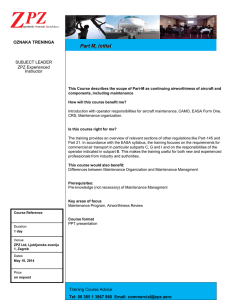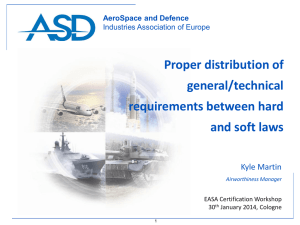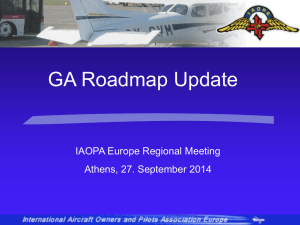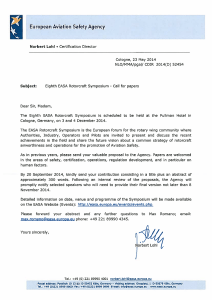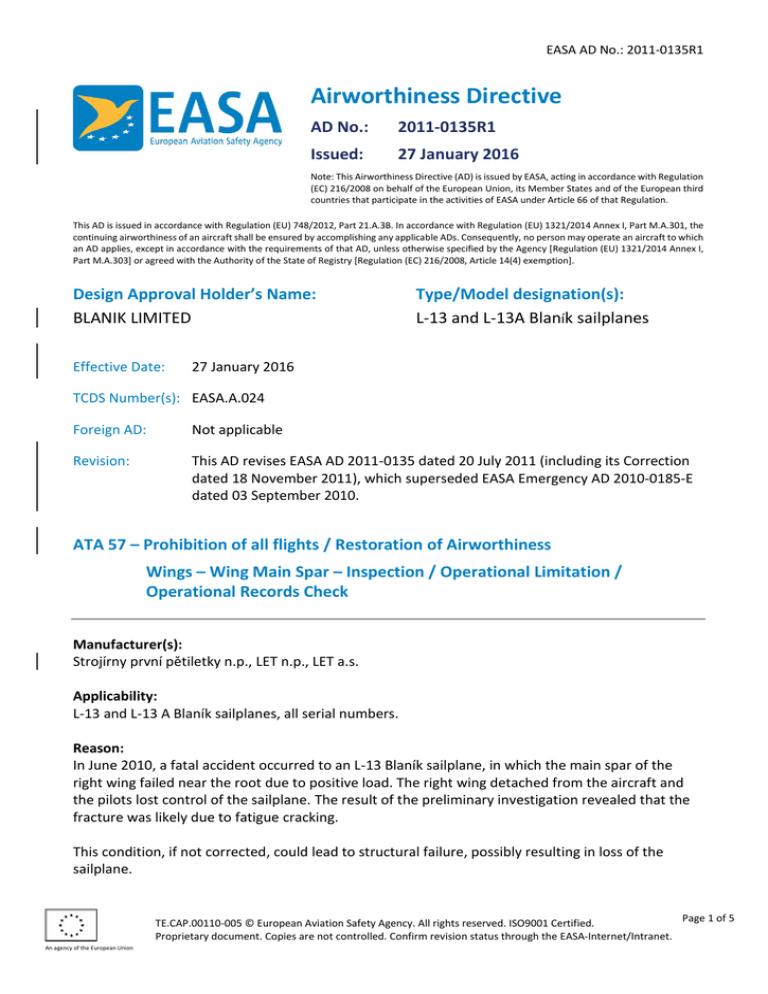
EASA AD No.: 2011-0135R1
Airworthiness Directive
AD No.:
2011-0135R1
Issued:
27 January 2016
Note: This Airworthiness Directive (AD) is issued by EASA, acting in accordance with Regulation
(EC) 216/2008 on behalf of the European Union, its Member States and of the European third
countries that participate in the activities of EASA under Article 66 of that Regulation.
This AD is issued in accordance with Regulation (EU) 748/2012, Part 21.A.3B. In accordance with Regulation (EU) 1321/2014 Annex I, Part M.A.301, the
continuing airworthiness of an aircraft shall be ensured by accomplishing any applicable ADs. Consequently, no person may operate an aircraft to which
an AD applies, except in accordance with the requirements of that AD, unless otherwise specified by the Agency [Regulation (EU) 1321/2014 Annex I,
Part M.A.303] or agreed with the Authority of the State of Registry [Regulation (EC) 216/2008, Article 14(4) exemption].
Design Approval Holder’s Name:
BLANIK LIMITED
Effective Date:
Type/Model designation(s):
L-13 and L-13A Blaník sailplanes
27 January 2016
TCDS Number(s): EASA.A.024
Foreign AD:
Not applicable
Revision:
This AD revises EASA AD 2011-0135 dated 20 July 2011 (including its Correction
dated 18 November 2011), which superseded EASA Emergency AD 2010-0185-E
dated 03 September 2010.
ATA 57 – Prohibition of all flights / Restoration of Airworthiness
Wings – Wing Main Spar – Inspection / Operational Limitation /
Operational Records Check
Manufacturer(s):
Strojírny první pětiletky n.p., LET n.p., LET a.s.
Applicability:
L-13 and L-13 A Blaník sailplanes, all serial numbers.
Reason:
In June 2010, a fatal accident occurred to an L-13 Blaník sailplane, in which the main spar of the
right wing failed near the root due to positive load. The right wing detached from the aircraft and
the pilots lost control of the sailplane. The result of the preliminary investigation revealed that the
fracture was likely due to fatigue cracking.
This condition, if not corrected, could lead to structural failure, possibly resulting in loss of the
sailplane.
Page 1 of 5
TE.CAP.00110-005 © European Aviation Safety Agency. All rights reserved. ISO9001 Certified.
Proprietary document. Copies are not controlled. Confirm revision status through the EASA-Internet/Intranet.
An agency of the European Union
EASA AD No.: 2011-0135R1
To address this potentially unsafe condition, EASA issued Emergency AD 2010-0119-E to require an
inspection of the main spar at the root of the wing to detect fatigue cracking and the
accomplishment of the relevant corrective actions, depending on findings. In addition, that AD
imposed operational limitations. Subsequently, EASA issued Emergency AD 2010-0122-E, retaining
the requirements of AD 2010-0119-E, which was superseded, and expanding the Applicability to
L-13 A Blaník sailplanes. The requirements of AD 2010-0122-E were considered an interim action to
immediately address the unsafe condition.
After EASA AD 2010-0122-E was issued, based on further information provided by the Austrian
Accident Investigation Board (AIB), EASA re-assessed the inspection method as described in Aircraft
Industries (AI) Mandatory Bulletin (MB) L13/109a and concluded that the inspection method might
not be sufficient for detecting a crack similar to those observed on the accident sailplane.
Based on these conclusions, EASA issued Emergency AD 2010-0160-E, retaining as an interim
measure the inspection requirements of AD 2010-0122-E, which was superseded, and required
determination of the specific usage of the sailplane, i.e. the ratio between normal flight and
aerobatics and, if an exceedance of certain limits was established, prohibited further flight.
After EASA AD 2010-0160-E was issued, additional analysis indicated that the L-13 Blaník accident,
in June 2010, occurred before the sailplane wing main spar reached its estimated fatigue safe life
limit. Consequently, the action as required by AD 2010-0160-E was considered insufficient to ensure
safe operation. Indeed, a high variability of the load levels and the frequency of load application
during aerobatic flight time was found, and therefore a high variability of the possibly induced
fatigue damage. This concern was accentuated when doubt existed on the completeness or
accuracy of aerobatic flight time records.
Based on this new insight and knowing that the inspection method as described in Aircraft
Industries MB L13/109a was possibly insufficient to detect the potential fatigue cracks, as a
conservative measure, EASA issued Emergency AD 2010-0185-E, superseding AD 2010-0160-E, to
prohibit all operations of L-13 and L-13 A Blaník sailplanes.
After EASA AD 2010-0185-E was issued, it was determined that Model L-13 A Blaník sailplanes had a
wing installed which was structurally less sensitive to fatigue than the wing installed on Model L-13
Blaník sailplanes. It was known that some L-13 Blaník sailplanes had been modified in service to
conform to the L-13 A Blaník type design, although the design status of their wing structure is
uncertain. Thus, it was necessary to identify the design of wing critical parts installed on the
sailplane.
Aircraft Industries issued MB L13/112a which contained instructions to enable identification of L-13
Blaník sailplanes that had a reinforced wing structure in conformity with the L-13 A Blaník type
design.
Consequently, EASA issued AD 2011-0135 to retain the flight prohibition imposed by EASA AD 20100185-E, which was superseded, and allowed sailplanes to be returned to flight with certain
operating limitations, provided certain actions were successfully accomplished, as described in
Aircraft Industries MB L13/112a, and depending on the sailplane usage ratio. In addition, that AD
included reference to Aircraft Design and Certification Ltd. modification ADxC-DC-39-001, which
Page 2 of 5
TE.CAP.00110-005 © European Aviation Safety Agency. All rights reserved. ISO9001 Certified.
Proprietary document. Copies are not controlled. Confirm revision status through the EASA-Internet/Intranet.
An agency of the European Union
EASA AD No.: 2011-0135R1
was approved under EASA Supplemental Type Certification (STC) 10035295, as an acceptable
alternative method to comply with the requirement of this AD. After modification of a sailplane in
accordance with this STC, flights could be resumed.
Since EASA AD 2011-0135 was issued, AI, on behalf of Blanik Limited, developed modification
TDC-002-L13-BL, available for in service sailplanes through MB No L13/117a, to reinforce the lower
wing attachment hinges.
This AD is revised to introduce that modification as an additional option that would allow a sailplane
to resume flight.
Required Action(s) and Compliance Time(s):
Required as indicated, unless accomplished previously:
(1) From 05 September 2010 [the effective date of AD 2010-0185-E], all flights are prohibited.
(2) After 20 July 2011 [the effective date of this AD at original issue], inspect the sailplane to
determine whether the wing structure is in conformity to the L-13 A Blaník design specification,
or in conformity to the L-13 Blaník ‘reinforced’ design specification, in accordance with the
instructions of AI MB No. L13/112a.
(3) If, as a result of the inspection required by paragraph (2) of this AD, conformity is NOT
demonstrated, all flights are prohibited.
(4) If, as a result of the inspection required by paragraph (2) of this AD, conformity is
demonstrated, accomplish all the additional actions specified in paragraphs (4.1), (4.2) and (4.3)
of this AD. Only after all actions have successfully been accomplished, flights can be resumed.
(4.1) Determine whether the sailplane records show compliance with each of the maximum
operation usage limits as detailed in Table 1 of this AD.
Table 1 - Maximum Limits
Type of Operations
Flight Hours (FH) or Winch Launches
(WL)
Aerobatic Flights
100 FH
Winch launches
25 000 WL
Dual Flights
2 500 FH
If the sailplane records are inconclusive, or if any of the types of operation exceeds the
maximum limit, contact the TC holder for approved instructions and accomplish those
instructions accordingly.
Page 3 of 5
TE.CAP.00110-005 © European Aviation Safety Agency. All rights reserved. ISO9001 Certified.
Proprietary document. Copies are not controlled. Confirm revision status through the EASA-Internet/Intranet.
An agency of the European Union
EASA AD No.: 2011-0135R1
(4.2) Inspect the areas of wing skin joints (ribs No. 7 and 13 of the wing) for cracks at ribs and
stringers in accordance with the instructions of AI MB No L13/108a. In case a failed
stringer or rib is detected, accomplish a repair in accordance with the instructions of AI
Information Bulletin (IB) No L13/107b.
(4.3) Amend the Aircraft Flight Manual (AFM) as follows: All aerobatics manoeuvres, e.g. Roll
(Výkrut), Loop (přemet), Stalled turn (souvrat), Immelmann turn (překrut), Half roll (zvrat)
and Inverted flight (let na zádech) are prohibited. This can be accomplished by inserting a
copy of this AD into the AFM and invalidating the following “aerobatics” chapter of the
AFM, as applicable:
- Do-L13.1111.1 (In Czech language),
- Do-L13.1111.3 (In English language),
- Do-L13.1111.2 (In German language),
- Do-L13.1111.4 (In Spanish language), or
- Do-L13.1111.5 (In Russian language)
Alternative method of compliance:
(5) As an alternative to the inspection required by paragraph (2) of this AD and the corrective
actions required by paragraph (4) of this AD, inspect and modify the sailplane in accordance
with the instructions of Aircraft Design and Certification Ltd. modification ADxC-DC-39-001.
After inspection and modification of a sailplane in accordance with paragraph (5) of this AD,
flights can be resumed with that sailplane, provided the applicable AFM and Maintenance
Manual (MM) are amended, in accordance with the instructions contained in Supplement
ADxC-39-001-AFM and ADxC-39-001-AMM, respectively.
or
(6) Modification of a sailplane in accordance with the instructions of AI MB No L13/117a
constitutes an alternative method to comply with the requirements, as specified in paragraphs
(1), (2), (3) and (4) of this AD.
After modification of a sailplane in accordance with paragraph (6) of this AD, flights can be
resumed with that sailplane.
Ref. Publications:
AI IB No L13/107b, dated 18 July 2011.
AI MB No L13/108a, dated 14 July 2011.
AI MB No L13/112a, dated 16 May 2011.
AI MB No L13/117a, dated 20 January 2016.
Aircraft Design and Certification Ltd. modification ADxC-DC-39-001, approved by EASA through STC
10035295, which includes associated documentation:
- ADxC-39-EO-013, Issue A, dated 01 April 11 (Template for installation of structural modification),
- ADxC-39-001-AFM dated 30 March 11 (AFM supplement), and
Page 4 of 5
TE.CAP.00110-005 © European Aviation Safety Agency. All rights reserved. ISO9001 Certified.
Proprietary document. Copies are not controlled. Confirm revision status through the EASA-Internet/Intranet.
An agency of the European Union
EASA AD No.: 2011-0135R1
- ADxC-39-001-AMM dated 11 June 11 (MM supplement).
The use of later approved revisions of these documents is acceptable for compliance with the
requirements of this AD.
Remarks:
1. If requested and appropriately substantiated, EASA can approve Alternative Methods of
Compliance for this AD.
2.
Based on the required actions and the compliance time, EASA have decided to issue a Final AD
with Request for Comments, postponing the public consultation process until after publication.
3.
Enquiries regarding this AD should be referred to the EASA Safety Information Section,
Certification Directorate. E-mail: ADs@easa.europa.eu.
4.
For any question concerning the technical content of the requirements in this AD, please
contact:
Blanik Limited,
2nd Floor Beaux Lane House
Mercer Street Lower
Dublin 2
Republic of Ireland
or
The contracted design organisation approval holder:
Aircraft Industries, a.s. - Na Záhonech 1177, 686 04 Kunovice, Czech Republic
Telephone: +420 572 817 660, Fax: +420 572 816 112
Email: ots@let.cz.
For any question concerning the technical content of Aircraft Design and Certification Ltd.
modification ADxC-DC-39-001, please contact:
Aircraft Design and Certification Ltd, Reichenstein Straße 48,
69151 Neckargemünd, Germany. Telephone: +49 176 322 69825,
Email: blanik@aircraftdc.de.
Page 5 of 5
TE.CAP.00110-005 © European Aviation Safety Agency. All rights reserved. ISO9001 Certified.
Proprietary document. Copies are not controlled. Confirm revision status through the EASA-Internet/Intranet.
An agency of the European Union

